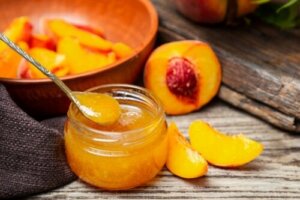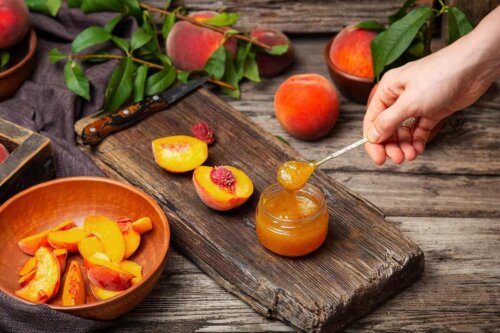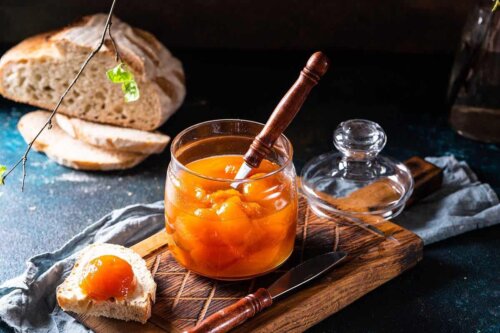A Simple Recipe for Homemade Peach Jam


Written and verified by the nutritionist Florencia Villafañe
A homemade peach jam is a great way to enjoy your breakfasts and snacks. It’s also a good way to make the most of this seasonal fruit. Continue reading to learn how to make it.
Peaches are highly versatile and their sweet flavor blends well with other ingredients in many recipes. It’s also a high source of vitamins, minerals, antioxidants, and other useful active compounds.
Homemade peach jam
People have been preserving food since ancient times and jams are great for making the most of seasonal fruits and keeping them from going to waste. Fortunately, this way of taking advantage of food also saves money. Also, the people who make them avoid the many harmful simple sugars and additives used by the food industry.
First of all, keep in mind that sugar isn’t only a sweetener. It’s also a preservative and thickener. In addition, you should know that peaches don’t have a high pectin content and your home jam won’t have the hard gelatinous consistency of an industrially processed one.
You’ll only need three ingredients to make this recipe as well as a pot, a spatula, and glass jars to store the finished product. Take note of the quantities below and follow the recipe as closely as you can.
Learn How to Make Raspberry Jam at Home
Ingredients
The proportion traditionally recommended for a homemade peach jam is an equal amount of sugar and fruit. However, you can obtain a product with more flavor and, therefore, less sweet if you reduce the amount of sweetener. So, with that in mind, you’re going to need the following:
- 2 lbs of ripe peaches without dents
- 1 lb of white sugar
- The juice of one lemon

Instructions for a homemade peach jam
Sterilizing the jars is the first thing you should do before you begin to make the jam. Keep in mind that you must store your preserves in clean containers, free of microorganisms, to avoid foodborne illness.
In fact, various studies revealed that people have been sterilizing these containers for a long time. This is because they already knew their homemade preserves would stay safe for a longer period of time.
Sterilization of jars
This consists of washing the jars and their respective lids with water and detergent. Then, rinse them thoroughly and immerse them in a pot of water. You must completely cover them so use a large pot.
Now, let the jars boil for half an hour. After this time (when the jam is almost ready), take them out and place them upside down on a metal rack. Then, allow them to cool.
Making the peach jam
- The first step is to wash, peel and dice the peaches. You must remove the pit, without wasting any of the pulp — do remove any darker dented spots.
- Next, measure the sugar and then place the chopped peaches in a large pot; add the sugar to it.
- Set the stove to low heat and start stirring with a spatula for 10 minutes so that the sugar begins to dissolve and mix with the juices released by the fruit.
- Squeeze the lemon juice, remove the seeds, and add it to the pot while waiting for this time to elapse. Continue to stir.
- Lower the temperature when it begins to boil and let it cook gently. Remember to stir at all times to keep the mixture from sticking to the pot and from splattering. The approximate cooking time is 30 to 45 minutes. However, this time depends on the degree of ripeness of the peaches and the intensity of the flame.
- Use a hand blender or mini blender to finish breaking up the peach pieces once the fruit begins to fall apart. This is a way to ensure a homogeneous consistency and save cooking time. You may just let the pieces of fruit mush on their own if you prefer.
- Tip. Here’s a technique to find out if the jam is ready: place a plate with a little bit of jam in the freezer. It should be thick and firm after a few seconds. You’ll need to cook it longer if it doesn’t.
Filling the jars
OK, so you’ve made your homemade peach jam. It’s now time to fill the jars as fast as you can before it cools down. To do so, fill them, put the lid on, and quickly turn them upside down on the counter.
Leave them in this position for 24 hours before you store them. This is how you achieve the vacuum effect — necessary to safely preserve the product.
The properties of peaches
This fruit is native to China but today we know it all over the world. According to data extracted from the book Alimentación Española, this fruit doesn’t have a high content of any specific nutrient.
However, vitamin C stands out among its micronutrients and covers more than 20% of the recommended daily intakes. In addition, it also provides carotenoids with provitamin A activity, dietary fiber, and minerals such as potassium.

Other facts to keep in mind about this recipe
Homemade peach jam can be high in calories due to the added sugar and so other recipes use alternative sweeteners. However, the role of sugar isn’t really about flavor here, it’s role is mainly to thicken the mixture.
For this reason, a lower amount of sugar will also require adding special gelling agents such as pectin powder, agar-agar, or another fruit, such as apple. The latter is a well-known thickener
Check out this Recipe for Homemade Cherry Jam
Enjoy the taste of homemade peach jam
This jam is great in breakfasts, snacks, and many other dishes. The most classic way to enjoy it is as a spread on toast, either by itself or along with fresh creamy cheeses. Furthermore, it’s also perfect for filling cakes, fruit tarts, cookies, or highlighting other flavors in sweet and sour recipes.
All cited sources were thoroughly reviewed by our team to ensure their quality, reliability, currency, and validity. The bibliography of this article was considered reliable and of academic or scientific accuracy.
-
Rossato SB, Haas C, Raseira Mdo C, Moreira JC, Zuanazzi JA. Antioxidant potential of peels and fleshes of peaches from different cultivars. J Med Food. 2009 Oct;12(5):1119-26. doi: 10.1089/jmf.2008.0267. PMID: 19857078.
- Libro la Alimentación Española. Melocotón. Disponible en: https://www.fen.org.es/storage/app/media/imgPublicaciones/2018/libro-la-alimentacion-espanola.pdf
- Mermeladas, dulces y confituras. Instituto Nacional de Tecnología Industrial. Disponible en: http://www.alimentosargentinos.gob.ar/HomeAlimentos/saiea/articulos/mermeladas%20INTI.pdf
- Manual de conservas caseras. Disponible en: https://inta.gob.ar/sites/default/files/script-tmp-10__manual_de_conservas_caseras.pdf
- Ancutza, M. A. (2019). Desarrollo de mermelada de naranja y quinoa (Chenopodium quinoa) y evaluación de alternativa de consumo casero (Doctoral dissertation, Universidad Nacional de Cuyo. Facultad de Ciencias Agrarias).
This text is provided for informational purposes only and does not replace consultation with a professional. If in doubt, consult your specialist.








